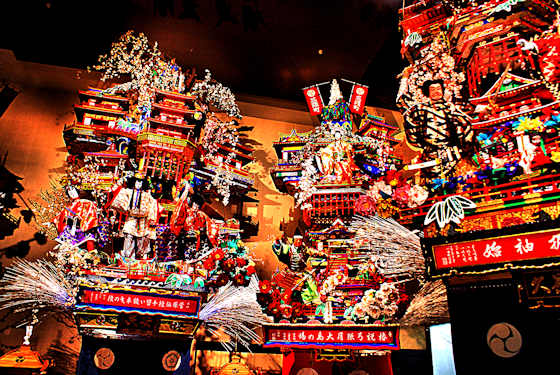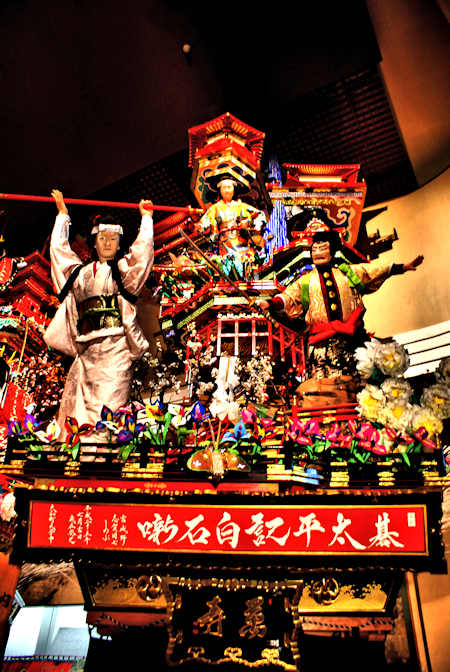Showing posts with label Matsuri. Show all posts
Showing posts with label Matsuri. Show all posts
Sunday, March 3, 2024
Yodohime Shrine Shimenawa & Yamodo Festival
Saturday, August 12, 2023
Nagasaki Shinchi the Oldest Chinatown in Japan
Labels:
chinatown,
kyushu108,
Matsuri,
nagasaki,
tojin yashiki
Tuesday, February 15, 2022
Hita Gion Matsuri Museum
Hita Gion Matsuri Museum
Hita, the historic town in the mountains of Oita, is one of many towns throughout Japan with their own Gion Matsuri, the festival that originated in Gion, Kyoto.
Friday, February 5, 2021
Yatsushiro Myokensai
Yatsushiro
I arrived at Yatsushiro Shrine in late November on the 44th day of my first walk around Kyushu. A few days earlier was the Yatsushiro Myokensai Festival which originates from the shrine. On display at the shrine are some of the "creatures" that are paraded during the festival.
Friday, October 25, 2019
Kagoshima Jingu
After getting my hotel room in Hayato I set off the explore the local shrine, Kagoshima Jingu, and was delighted to discover that this evening was going to be the Summer Matsuri and the shrine approach was lined with stalls setting up and large lanterns decorated with chidrens painting hung everywhere.
The wooden horse at the entrance was far more decorative than any other shrine horse I had seen because this one is how a horse is decorated for the Hatsu Uma Festival when the horse leads a procession to the shrine. The festival is said to originate from a dream had by the regional Daimyo who had slept at the shrine.
There are a lot of secondary shrines throughout the extensive grounds as this was the Ichinomiya, the highest ranked shrine in the province of Osumi which today forms the eastern half of Kagoshima Prefecture. The main enshrined kami are Hoori and Toyotamahime, the grandparents of the mythical first emperor Jimmu and legend says it was founded at that time.
This is the southern Kyushu variation of the founding myth of Japan that more usually places the activity further north in the mountains of Miyazaki around Takachiho. The ceiling of the main hall is decorated with hundreds of paintings of regional plants.
Also enshrined here are Emperor Ojin and his mother Jingu, collectively enshrined as Hachiman. There are quite a few huge camphor trees in the grounds too....
Labels:
hayato,
hoori,
horse,
ichinomiya,
jingu,
kyushu108,
Matsuri,
ojin,
Shrine,
toyotamahime
Thursday, May 14, 2015
Pacifying the River Gods
This is a photo of the largest Onusa, from the biggest of the Suijin festivals held in Kawado. I did not attend this year as I was away but I have posted on it before, here, here, and here.
Tuesday, October 28, 2014
Autumn Matsuri 2014 part 2
When we arrived at the shrine at 10:30 the Shioharae was in progress. This is usually the second dance of the night and purifies the dance area for the rest of the nights performances. It is a shinji, a ceremonial dance as opposed to a theatrical dance. There was a TV crew from Tokyo filming the visiting American "dancer" and I found the performance of the audience a little disconcerting.
Next up was Yumi Hachiman, a 2 man dance featuring the hero Hachiman, the patron kami of the shrine, defeating a demon.
It is a standard fighting dance where good triumphs over evil and featuring a spectacular smoke and firework entrance of the demon.
Our local kagura troupe are really good. They are all amateurs, but their performances are always tight and professional. The next dance was Kakko-Kirime. The first part involves Kakko, somewhat of a fool, who steals a sacred drum from a shrine and attempts, unsuccessfully to activate it. I like the dance because it allows the dancer to incorporate a lot of his own moves and sequences. In the second half of the dancer the kami Kirime descends and teaches kakko the correct way.
I left then, past midnight. There was to be 6 more hours of dancing, but I was feeling out of sorts and I needed to be fresh for the final part of the matsuri, a series of ceremonies tomorrow morning followed by the carrying of the mikoshi.....
Sunday, October 26, 2014
Autumn Matsuri 2014 part 1
Last weekend was my villages annual Autumn Matsuri. The rice has been harvested, time to kick back and party. Though our village, like many others, has shifted away from using the traditional lunar calendar to set the date, it has also, like many others, shifted the date of the matsuri to fall on a saturday, so that many people have tomorrow off.
We arrived about 10:30, and things were in full swing because traditionally matsuris were all night affairs, and most villages in my area still continue with this tradition. There were fires to keep everyone outside the shrine warm, though it was still warm weather..... by 5 or 6 in the morning it will be cooler.
There was plenty of food and drank available. Made by local people, not the itinerant vendors who are a feature of city festivals, and the food was for sale, not free. I prefer the smaller villages up in the mountains that still provide free food and drink.
There were plenty of people milling around outside the shrine, but most were inside watching the kagura.....
Labels:
Matsuri,
Shimonohara,
Shrine
Monday, May 5, 2014
An unexpected Matsuri
On the afternoon of September 4th, 2011, I was approaching Byodo-ji, Temple 22 of the Shikoku Pilgrimage, when I spied a torii with banners flying, a sign that a matsuri is underway.
As I got closer I could hear the shouts of children which suggested that the matsuri was underway at the moment. For me, there is no greater pleasure than coming upon a matsuri, especially one in a rural village shrine.
It was a Yasaka Shrine, a branch of the famous shrine in Kyoto formerly lnown as Gionsha. The main kami is Susano, and also many of his "family", which is kind of apt as he is known as the kami of storms and the last 2 days this area has been hit with a massive typhoon.
There wasn't anything going on right now. Kids were running around and playing, and a small group of the village elders were inside eating and drinking. They invited me in for food and beer, and though daytime drinking in the heat of the day is not a usual habit of mine, as I was a pilgrim I could not refuse their offer.
After a second beer I insisted I had to leave and they showed me a path leading out of the shrine which was a shortcut over the hill to Byodo-ji
Tuesday, August 20, 2013
Gonokawa Matsuri Parade
Last saturday was the Gonokawa Matsuri, the social event of the season in Gotsu. All the young females of the species were in their finest.....
The parade consisted of a long line of various civic groups and clubs and companies each in their own style of outfit performing the "dance"..... very few people actually seeme dto be enjoying it....
Kakinomoto Hitomaro, the famed 7th Century poet whose work is well represented in the Manyoshu. His wife, also a famous poet, was a local girl.....
The one group that made a lot of noise and actually seemed to be enjoying themselves were the High School Rugby team.....
And of course no parade would be complete without traditional Japanese hula dancers....
Subscribe to:
Posts (Atom)















































